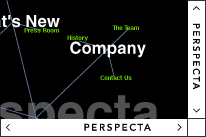
MEDIA LAB PROJECTS

In late 1993, Earl Rennison began work on a project that would form the conceptual foundation of much of the technology being developed by Perspecta. "What if instead of filtering information, we could see all the news simultaneously on a single screen?" asked mentor Muriel Cooper. In response to this provocative question, Rennison conceived of Galaxy of News, a system that focused on the categorical organization and presentation of information whereby a user could:
- Effectively browse through large news spaces
- Combine the effective aspects of both browsing and searching/filtering at the same time
- Visualize relationships between articles based on a conceptual representation of the content
- Experience dynamic "level-of-detail" selection that allows the user to quickly see information at a level of detail that matches their level of interest
- Directly interact with the content without relying upon menus, sliders, buttons or other interface elements
- Engage in a continuous interaction with the computer that replaces the traditional point/click metaphor with a more natural type of continuous and intelligible transition
- Quickly access related information and understand the relationship between old and new information
 user's query and keyword searches. But these systems are generally as good as the user's
ability to define a query specific enough to find particular documents. If the initial
query doesn't produce the proper documents, it's difficult to reformulate the query for
better results. While filtering systems may reduce the overload of information, the burden
still rests upon the reader to make sense of the reduced set. Furthermore, these systems do
not show the relationships between the returned documents.
user's query and keyword searches. But these systems are generally as good as the user's
ability to define a query specific enough to find particular documents. If the initial
query doesn't produce the proper documents, it's difficult to reformulate the query for
better results. While filtering systems may reduce the overload of information, the burden
still rests upon the reader to make sense of the reduced set. Furthermore, these systems do
not show the relationships between the returned documents.
In contrast, Galaxy of News employed a "visual discourse" metaphor that modeled the movement from one image to another as a "dialog" with the computer. Move closer to a piece of information to receive more detail, move farther away to abstract and summarize. One of the core enabling technologies developed by Rennison was a process to automatically build a structure that captured the relationships between news articles. Without having any prior knowledge about the content, this process derived organizational hierarchies, as well as multi-dimensional relationships, solely from "tags" about the content of the articles.
In other words, Galaxy of News took unstructured information and organized it into meaningful structures. These structures helped people understand what the collection of documents as a whole was about. People could get a high-level view of the news without having to read all of the articles. And as users focused in on a subject of interest, they could better understand what the articles were about because the visual representation provided context.
The Galaxy of News project was a focus for an Atlantic Monthly article entitled "Navigating the Galaxies" by James Fallows (April 1996). In the article, Fallows evaluated several new technologies that were designed to make sense of the uncodified information on the Internet.
In regards to Galaxy of News, Fallows wrote, "[Galaxy of News] starts out on the computer screen with what looks like a view of several distant nebulae. As you use the mouse to move closer to these star clusters, they turn out to be large subject areas - government, sports, entertainment, and so on. As you near one of these areas, tiny rays appear, leading to sub-topics - local politics, national politics, foreign affairs and so on. The farther you move in any direction, the more refined the topics become, until at last the rays lead to a variety of headlines from relevant articles. . . . the whole experience was reminiscent of a Star Trek scene. But speaking as one who has bragged about being skeptical of graphics and preferring just words, I found this enhancement powerful and natural - much quicker to make sense of, for example, than a long list of articles produced by a Nexis search."
Copyright ©1997 Perspecta, Inc. All Rights Reserved.